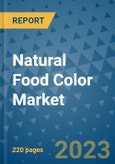The global natural food color market is experiencing positive trends, driven by a shift towards natural food colors in comparison to synthetic alternatives. Increasing health awareness, concerns about food adulteration, and consumer spending power have led to a rising demand for clean label products and natural ingredients worldwide. Although limited availability of raw materials and higher costs may pose challenges, the market is benefiting from proliferating end-use applications. Manufacturers globally are focusing on expanding their portfolios of natural food and beverage products.
COVID-19 Pandemic Boosts Demand for Locally Produced and Naturally Derived Food
During the COVID-19 pandemic, there was a significant shift in global consumption towards locally produced food. Concerns about infection and skepticism regarding the origin of ingredients led to increased demand for naturally produced and home-cooked food. Additionally, the recommendation to use nutraceuticals for improving immunity and health has further fueled the growth of the natural food colorant industry.
Algae Emerges as an Efficient Substitute for Synthetic Dyes, Driving Market Growth
Recent bans on artificial food dyes in various countries have had a significant impact on the market, leading many food manufacturing companies to adopt natural food additives. This has resulted in substantial reformulations of food products such as beverages, candies, and snacks. Looking ahead, the demand for natural food color additives, particularly algae, is expected to increase exponentially. Algae offers a wide range of colors and hues, making it an efficient source for developing safe and natural food dyes. Its viability, non-carcinogenic properties, and rapid growth cycle are driving tremendous growth in the natural food color market.
Asia Pacific Leads in Market Growth; North America Shows Moderate Growth
According to the report, Asia Pacific is the fastest-growing region in the global natural food color market. The strong adoption of natural food colors in the food and beverage industry and the penetration of clean label food products are expected to drive notable gains in the region. The outbreak of COVID-19 has led to a preference for homemade food, further boosting the demand for natural food colors. The emerging economies of India and China present higher growth prospects in the Asia Pacific region.
In contrast, North America is expected to show moderate growth, particularly in developed economies. Stringent regulations regarding the use of synthetic colors containing mercury, lead, and arsenic are driving the demand for natural food colors in the region. The market is projected to experience significant growth throughout the forecast period.
Key Players Strengthen Market Positions through Mergers, Acquisitions, and Collaborations
The study anticipates positive trends in the natural food color market, driven by new product launches, mergers, acquisitions, and production changes. Key players in the global market include Symrise AG, Archer Daniels Midland, Kalsec Inc., Kerry Group Plc., and Naturex S.A. These players are focused on strengthening their market positions through strategic collaborations and acquisitions.
Table of Contents
Companies Mentioned
- Naturex S.A.
- Archer Daniels Midland Company (ADM)
- Döhler GmbH
- Symrise AG
- Oterra
- McCormick & Company
- Kalsec Inc.
- DDW
- Givaudan
- ROHA Dyechem Pvt. Ltd. (JJT Group)
- Sensient Technologies Corporation
- AFIS (Australian Food Ingredient Suppliers)
- San-Ei Gen F.F.I Inc.
- LycoRed
Methodology

LOADING...








